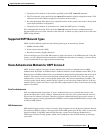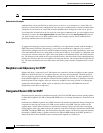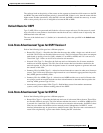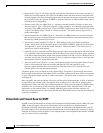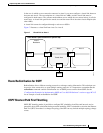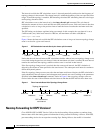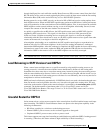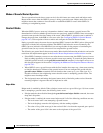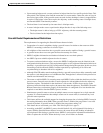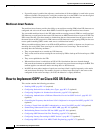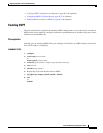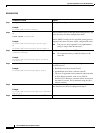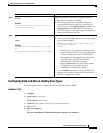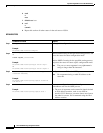
Implementing OSPF on Cisco IOS XR Software
Information About Implementing OSPF on Cisco IOS XR Software
RC-142
Cisco IOS XR Routing Configuration Guide
Modes of Graceful Restart Operation
The two operational modes that a router can be in for this feature are restart mode and helper mode.
Restart mode occurs when the OSPFv3 process is doing a graceful restart. Helper mode refers to the
neighbor routers that continue to forward traffic on established OSPFv3 routes while OSPFv3 is
restarting on a neighboring router.
Restart Mode
When the OSPFv3 process starts up, it determines whether it must attempt a graceful restart. The
determination is based on whether graceful restart was previously enabled. (OSPFv3 does not attempt a
graceful restart upon the first-time startup of the router.) When OSPFv3 graceful restart is enabled, it
changes the purge timer in the RIB to a non-zero value. See Configuring OSPFv3 Graceful Restart,
page RC-181, for descriptions of how to enable and configure the Graceful Restart feature.
During a graceful restart, the router does not populate OSPFv3 routes in the RIB. It tries to bring up full
adjacencies with the fully-adjacent neighbors that OSPFv3 had before the restart. Eventually, the
OSPFv3 process indicates to the RIB that it has converged either for the purpose of terminating the
graceful restart (for any reason) or because it has completed the graceful restart.
The following are general details about restart mode. More detailed information on behavior and certain
restrictions and requirements appear in the Graceful Restart Requirements and Restrictions section.
• If the OSPFv3 attempts a restart too soon after the most recent restart, the OSPFv3 process is most
likely crashing repeatedly, so the new graceful restart stops running. To control the period between
allowable graceful restarts, use the graceful-restart interval command. A description of how to set
this time period appears in the section Configuring the Minimum Time Required Between Restarts,
page RC-183.
• When OSFPv3 starts a graceful restart with the first interface that comes up, a timer starts running
to limit the duration (or lifetime) of the graceful restart. You can configure this period with the
graceful-restart lifetime command. On each interface that comes up, a grace LSA (type 11) is
flooded to indicate to the neighboring routers that this router is attempting graceful restart. The
neighbors enter into helper mode.
• The designated router and backup designated router check of the hello packet received from the
restarting neighbor is bypassed because it might not be valid.
Helper Mode
Helper mode is enabled by default. When a (helper) router receives a grace LSA (type 11) from a router
that is attempting a graceful restart, the following events occur:
• If helper mode has been disabled through the graceful-restart helper disable command, the router
drops the LSA packet.
• If helper mode is enabled, the router enters helper mode if all of the following conditions are met.
–
The local router itself is not attempting a graceful restart.
–
The local (helping) router has full adjacency with the sending neighbor.
–
The value of lsage (link state age) in the received LSA is less than the requested grace period.
–
The sender of the grace LSA is the same as the originator of the grace LSA.




